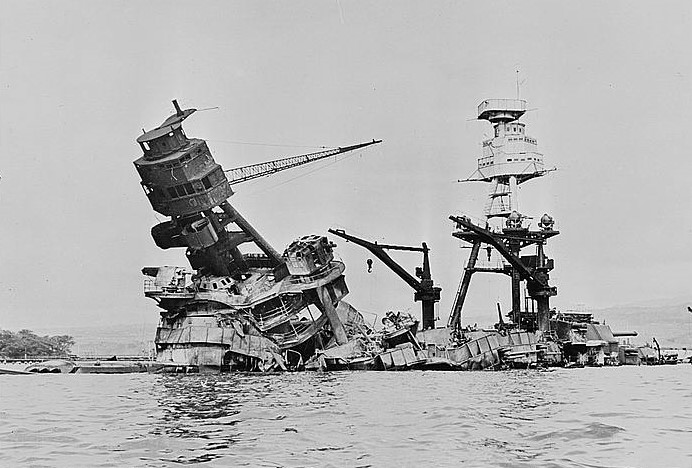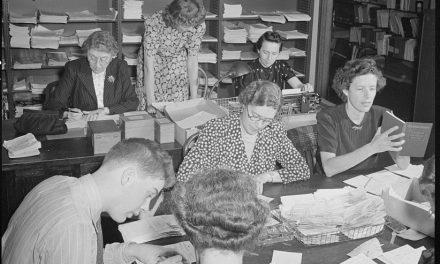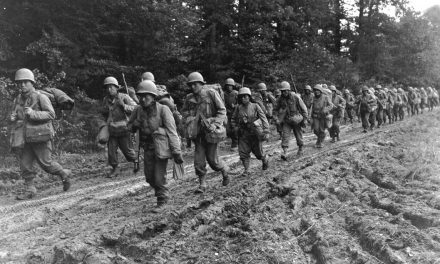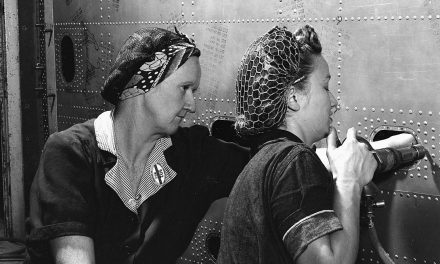Guns firing. Bombs exploding. Screams of terror piercing the air. That is what December 7, 1941 sounded like to the men and women in Honolulu, Hawaii. Now, months later, John Anderson of the U.S. Navy recalls his experience aboard the USS Arizona during the attack on Pearl Harbor.
The Japanese attack against the U.S. Navy started at around 8 a.m. Anderson and his brother were stationed on the USS Arizona. When Anderson went to get something to eat, he heard a loud explosion.
He remembers turning to someone and exclaiming, “What in the Dickens is that?”
One of the cooks looked out of the window and called for Anderson to come. When the two went out onto the deck, Anderson saw the red dots on the planes and said to the cook, “The Japanese are here.”
According to Anderson, they all had a feeling something along the lines of a Japanese attack was going to happen – they just did not know when. Anderson ran back to pull the general alarm on the ship, but before he could reach it, a bomb dropped between him and the vessel, blowing him inside the hatch. The Japanese were firing their machine guns on the ship decks, and more bombs exploded around them.
Anderson then got into the seat of the turret, ready to fire back on the Japanese. However, Anderson did not see any Japanese ships, but all planes. He knew he would not be much help inside the turret, which is what he told the ship’s captain.
“Well what do you suggest?” the captain asked him.
“Well we can’t do any good in here. I’d like to get out there and get on a gun with my brother,” Anderson responded.
“Go for it,” the captain said.
Now with the permission of the captain, Anderson persuaded a couple of the other guys who were with him to go to the ship’s deck. They escaped through a trapdoor and started climbing a ladder. When they reached the top, however, a gigantic explosion blew people across the deck. Knocked backwards, Anderson managed to grab a man who was on fire and saved his life by dragging him away from the deck.
“He was from Greenfield, Ohio,” Anderson said. It was something he said he will always remember.
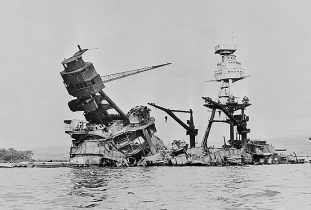
The USS Arizona (on which John Anderson was stationed) following the Japanese attack on Pearl Harbor, December 7, 1941. From Library of Congress.
There were small boats coming by and trying to take wounded men to the shore. Anderson was commanded to get on one of the boats, but he refused. His brother was still on the Arizona somewhere and he was determined to find him, despite the fact that people told him that his brother could not possibly have made it. The boat was going down any minute at this point, yet Anderson was not leaving without his brother.
“I’m not leaving . . . my brother is someplace – I gotta find him!”
A bomb hit the turret that Anderson had been in just moments before. It skidded off the face plate, fell down below and exploded, killing members of the Combat Information Center (CIC) – an area containing radar equipment, internal and external communication devices, and plotting devices.
A lieutenant ordered Anderson into one of the small boats. Anderson refused once again – he had still not found his brother – but the lieutenant grabbed him and shoved him in the boat. Anderson vocalized how badly he did not want to go, but the boat was off to shore.
After dropping off the wounded, he brought the boat back out to the Arizona in hopes to not only find his brother, but to help others still trapped aboard the flaming ship. He was able to rescue three men, but on the way back, a shell hit their boat and blew it apart. After all the danger Anderson went through to save the lives of the three men, Anderson was the only one who survived the explosion. The oil sitting atop the water was aflame, and he did what he could to survive – swim back to shore while trying to dodge bullets and bombs from the planes. He was not the only one in the water. He tried to find anyone still alive and get them to shore – to Ford Island. He just got too tired. He could not do it anymore.
With his last bit of energy, he found his way back to shore and collapsed onto the beach. The Japanese were still firing down upon them all. By the looks of it, Anderson assumed a new wave of planes had been sent. As the planes got closer to the beach, Anderson had no choice but to get up.
As he ran up to the runway, he saw a rifle and ammunition hanging from a tree branch. When he also found a bomb-hole, he decided that was where he was going to make his stand. A guy named Walt approached him with a machine gun and said, “Let’s give them hell.” They stayed there all night.
The next morning, in the wake of the attack, a group of Marines stumbled across the two men. The Marines were out searching for wounded men and women, and sent Anderson and Walt to 1010 Dark, a base across from Ford Island on the mainland of Honolulu. They were greeted by 200 other Arizona survivors. The doctor (Commander Geiselman) belonged to the Arizona as well, yet he had not been on the ship during the Japanese attack. He organized all the men together, categorizing who needed to go to the hospital, who needed to be wrapped up right on the spot and who was fine overall.
Commander Geiselman told the men who were healthy and strong enough that they must find the ships that lost a lot of men and were in desperate need of replacements. Anderson was a great sailor and knew his skills were of use. Despite the fact that Anderson had not found his brother and wanted to stay with the other Arizona survivors, he agreed to the task.
He was sent to the destroyer McDonough in the Pacific, where he remains today, hoping to strike back at the Japanese. To this day, Anderson has still not found his brother. Nobody had any information on what may have happened to him. Anderson believes his brother died upon the Arizona, like so many others. In spite of the possibility of his brother’s death and the devastation he has witnessed, Anderson continues to do his nation proud as a member of the U.S. Navy.
Source: Oral history interview conducted by Don Smith, NewsVideo.com.

